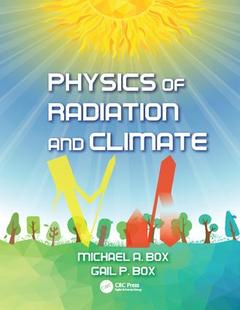Description
Physics of Radiation and Climate
Authors: Box Michael A., Box Gail P.
Language: English
Subject for Physics of Radiation and Climate:
Keywords
Longwave Radiation; Optical Thickness; Aerosol chemistry; Greenhouse Gases; Radiation physics; Radiative Transfer Equation; Climate physics; Actinic Flux; Geoengineering; Physical Science Basis; Energy Balance; Air Parcel; Dry Adiabatic Lapse Rate; Pressure Gradient Force; Aerosol Size Distribution; Saturation Vapour Pressure; Coriolis Force; UV Spectral Region; Radiative Transfer; Backscatter Cross Section; Aerosol Particles; Cloud Albedo; Stratospheric Aerosol; Hydrostatic Equation; Aerosol Types; Water Vapour; Backscattered Fraction; Cloud Droplets; Photochemical Smog
Publication date: 07-2017
· 21x28 cm · Hardback
Publication date: 10-2015
· 21x28 cm · Paperback
Description
/li>Contents
/li>Readership
/li>Biography
/li>
Our current climate is strongly influenced by atmospheric composition, and changes in this composition are leading to climate change. Physics of Radiation and Climate takes a look at how the outward flow of longwave or terrestrial radiation is affected by the complexities of the atmosphere?s molecular spectroscopy. This book examines the planet in its current state and considers the radiation fluxes, including multiple scattering, photochemistry, and the ozone layer, and their impact on our climate overall.
Starting from the physical fundamentals of how electromagnetic radiation interacts with the various components of the Earth?s atmosphere, the book covers the essential radiation physics leading to the radiative transfer equation. The book then develops the central physics of the interaction between electromagnetic radiation and gases and particles: absorption, emission, and scattering. It examines the physics that describes the absorption and emission of radiation, using quantum mechanics, and scattering, using electromagnetism. It also dedicates a detailed chapter to aerosols, now recognized as a key factor of climate change. Written to be used for a first course in climate physics or a physics elective, the text contains case studies, sample problems, and an extensive reference list as a guide for further research.
In addition, the authors:
- Provide a complete derivation of molecular spectroscopy from quantum mechanical first principles
- Present a formal derivation of the scattering of radiation by molecules and particles
- Include the latest results from the Intergovernmental Panel on Climate Change Fifth Assessment Report (IPCC AR5)
Physics of Radiation and Climate shows howradiation measurements are used to aid our understanding of weather and climate change and provides an introduction to the atmosphere. This book covers the key branches of physics with a specific focus on thermodynamics, electromagnetism, and quantum mechanics.




